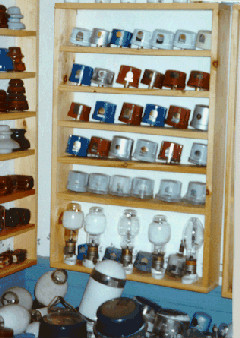
My assortment of photocontrols mostly are Fisher Pierce models and Ripley SunSwitches. I have various types of Fisher Pierce tube type controls and plastic cased twist-lock units. My favorite is a very early twist-lock model made in late 1956 and has a small neon lamp indicator on a short metal stem sticking out of the top of the control. It is a painted-inside gray plastic unit, the same size as the later photocontrols that Fisher Pierce commercially introduced in mid-1958. The neon lamp example has a small aperture window that is square. Later twist-lock Fisher Pierce photocontrols in the collection are dated from May 1958 through the present. These include the 500-watt, 120-volt (red painted inside) models and 240-volt units that are inside painted blue. Fisher Pierce did away with painting the inside of their photocontrol covers during early 1971, using solid colored plastic from then on. Ripley SunSwitches were less commonly used in this area, probably because the Fisher Pierce plant was nearby, in Braintree, Massachusetts. My earliest Ripley is a tall plastic, silver, painted-inside twist-lock made in 1960. Like the Fisher Pierce photocontrols, I have an assortment of Ripley SunSwitches produced from the '60s on.
Street lighting lamps in my collection range from old series incandescents and mercury lamps made through the late 1960s. Of substantial interest is a General Electric Mazda 1000 lumen, 6.6 ampere, PS-25 lamp that was factory painted flat black from its base to about its widest midsection so that its light output shined directly downwards. This unused example was made during World War II and its purpose was so that any enemy aircraft could not see illumination on land during the war's "blackout" years along the country's coastline.

Other street lighting lamps of significance include four different 400 watt tubular style, mogul base types produced in the late 1940s or early 1950s; a 1961 vintage yellow phosphor 400 watt Sylvania mercury lamp which was designed to illuminate dangerous intersections with "caution yellow" light; an early version of a deluxe white mercury lamp which is phosphor coated inside and has a purple-like stain on its outside. This lamp was to improve mercury lamp color rendition and was made in 1965 and is of the 175-watt size. Additional mercury lamps are of differing and odd shapes used for street lighting. Some of the BT shaped examples on exhibit are clear and phosphor lamps dating back to the 1960s and are still in working condition; some having seen 30 or more years of service. I am always fascinated by mercury lamps and am always looking for any of the earlier (1960s and earlier) ones, as well as any that are out of the ordinary. Many of the older merc bulbs are characterized by having ceramic starting resistors instead of the black carbon ones used later. In addition, many of the early day mercury lamps were tubular and/or generally straight sided. There were many mercury lamp variations produced through the years and this variety always keeps me looking!
Since the awakening of my street lighting avocation in the late 1970s, I have been actively pursuing any literature pertinent to this subject (i.e., catalogs, technical manuals, etc.). Some of the material I have been able to acquire dates back to the 1890s and is most valuable and entertaining as it assists in identifying and dating street light fixtures seen in service and in my collection. My research library also has been of much value to other collectors and enthusiasts by providing similar documentation about fixtures and street lighting accessories inquired about.